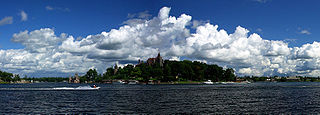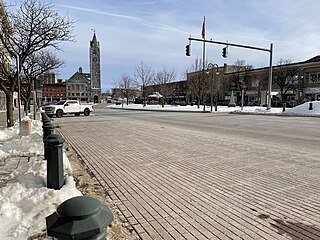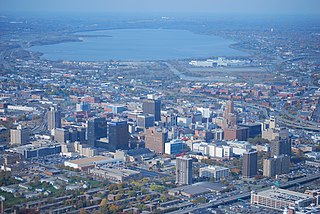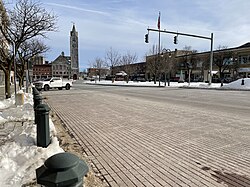
Jefferson County is a county on the northern border of the U.S. state of New York. As of the 2020 census, the population was 116,721. Its county seat is Watertown. The county is named after Thomas Jefferson, third President of the United States of America. It is adjacent to Lake Ontario, southeast from the Canada–US border of Ontario.

Globe is a city in Gila County, Arizona, United States. As of the 2020 census, the population of the city was 7,249. The city is the county seat of Gila County. Globe was founded c. 1875 as a mining camp. Mining, tourism, government and retirees are most important in the present-day Globe economy.

Menands is a village in Albany County, New York, United States. The population was 3,990 at the 2010 census. The village is named after Louis Menand. The village lies inside the town of Colonie and borders the northern city line of Albany.
Black River is a village in Jefferson County, New York, United States. The population was 1,348 at the 2010 census. The village is on the border of the towns of Le Ray and Rutland, east of Watertown.
Carthage is a village in the town of Wilna in Jefferson County, New York, United States. The population was 3,747 at the 2010 census. The village is named after the historic city of Carthage.
Chaumont is a village in Jefferson County, New York, United States. Its population was 624 at the 2010 census. The village is named for Jacques-Donatien Le Ray de Chaumont, son of Benjamin Franklin's landlord and friend at Passy in France. The village of Chaumont is in the town of Lyme and is northwest of Watertown.
Henderson is a town in Jefferson County, New York, United States. The population was 1,360 at the 2010 census. The town is named after William Henderson, the original European-American land owner.

Frank Winfield Woolworth was an American entrepreneur, the founder of F. W. Woolworth Company, and the operator of variety stores known as "Five-and-Dimes" which featured a selection of low-priced merchandise. He pioneered the now-common practices of buying merchandise directly from manufacturers and fixing the selling prices on items, rather than haggling. He was also the first to use self-service display cases, so that customers could examine what they wanted to buy without the help of a sales clerk.

The F. W. Woolworth Company was a retail company and one of the pioneers of the five-and-dime store. It was among the most successful American and international five-and-dime businesses, setting trends and creating the modern retail model that stores follow worldwide today.
Watertown is a town in Jefferson County, New York, United States. The population was 4,470 at the 2010 census. The town is located in the central part of the county and borders the city of Watertown to the south, east, and west. As the city has a population of 24,685, or six times the town's population, references to "Watertown, New York", usually apply to the city rather than the town.

Watertown is a city in, and the county seat of, Jefferson County, New York, United States. It is approximately 25 miles (40 km) south of the Thousand Islands, along the Black River about 5 miles (8 km) east of where it flows into Lake Ontario. The city is bordered by the town of Watertown to the south, east, and west, and is served by the Watertown International Airport and the Watertown Daily Times newspaper. In the middle of Watertown lies the Public Square Historic District, which was built in 1805 and listed on the National Register of Historic Places (NRHP) in 1984. Watertown is located 13 miles southwest of the U.S. Army base at Fort Drum; it is the service and shopping destination for personnel there and their families. As of the 2020 United States Census, the city has 24,685 residents, making it the largest city in the North Country.

Downtown Syracuse is the economic center of Syracuse, New York, and Central New York, employing over 30,000 people, and housing over 4,300.

The Paddock Arcade is a 19th-century shopping mall located in Watertown, New York. Built in 1850, it is the second oldest covered shopping mall and the oldest continuously running enclosed shopping mall in the United States. Since it has seen uninterrupted use since it opened in 1850, it carries the distinction of being the country's oldest, continuously operating covered shopping mall. The Paddock Arcade was listed on the National Register of Historic Places in 1976.

New York State Route 12E (NY 12E) is a state highway located entirely within the northwestern part of Jefferson County in northern New York in the United States. The southern terminus is at NY 12F in the village of Brownville. Its northern terminus, both signed and official, is at NY 12 in the village of Clayton. While NY 12 follows a direct north–south routing between Watertown and Clayton, NY 12E diverges westward to follow the shoreline of Lake Ontario. The portion of NY 12E north of its junction with NY 180 is part of the Seaway Trail, a National Scenic Byway.

The Cannon Building in Troy, New York is located on Broadway between First and State streets. It is the oldest building on Monument Square. It was designed by Alexander Jackson Davis and built in 1835. In 1970 it was listed on the National Register of Historic Places. It is also a contributing property to the Central Troy Historic District, listed on the Register in 1986.

The Central Troy Historic District is an irregularly shaped, 96-acre (39 ha) area of downtown Troy, New York, United States. It has been described as "one of the most perfectly preserved 19th-century downtowns in the [country]" with nearly 700 properties in a variety of architectural styles from the early 19th to mid-20th centuries. These include most of Russell Sage College, one of two privately owned urban parks in New York, and two National Historic Landmarks. Visitors ranging from the Duke de la Rochefoucauld to Philip Johnson have praised aspects of it. Martin Scorsese used parts of downtown Troy as a stand-in for 19th-century Manhattan in The Age of Innocence.

Jefferson County Courthouse Complex is a courthouse complex and national historic district located at Watertown in Jefferson County, New York. The district includes three contributing buildings; the courthouse building (1862), Clerk's Office (1883–1884) and Surrogate's Office (1905). The courthouse building is a two-story, red brick structure with limestone trim. It features a three-story tower on the northwest corner. It was designed by architect Horatio Nelson White.

The Roswell P. Flower Memorial Library is a historic library building located in Watertown in Jefferson County, New York. The library was built in 1903 through 1904, and completed on November 10, 1904. The library opened on January 4, 1905. It was donated to the city by Emma Flower Taylor as a memorial to her father Roswell P. Flower (1835–1899), the 30th governor of New York. A genealogy department, local history collection and meeting rooms are inside the building. It also contains computers available for public use. The library serves as the primary library in Watertown and surrounding communities as a center for reading, culture and research. It was listed on the National Register of Historic Places in 1980.

The Woolworth Building is a historic building in Watertown, New York. It is a contributing building in the Public Square Historic District. Plans for the Woolworth Building were begun in 1916 by Frank W. Woolworth, the founder of the Woolworth's chain of department stores.
The history of Watertown, a city in Jefferson County, New York, can be traced to the purchase of Upstate New York by Alexander Macomb, leading to a settlement east of Lake Ontario in the early 19th century. The area had seen human occupation since at least the second glacial period, but significant change into what is now known as Watertown did not occur until the beginning of the Machine Age. The city, which was incorporated in 1869, had expanded primarily through trade with Canada. The city destroyed many factories and historical buildings in the 1960s, which began a steady decline in population, from 33,306 in 1960 to 24,685 in 2020, a loss of 26%.





















